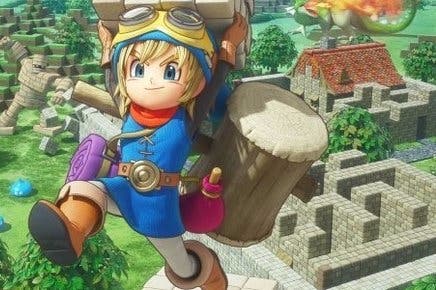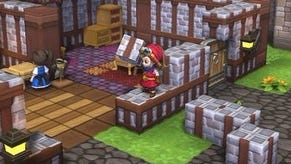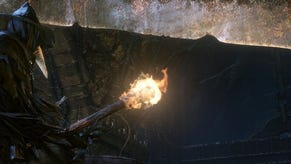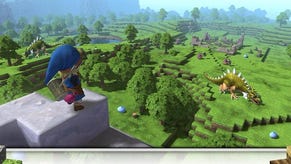How Japan's best-loved RPG is bringing structure to those paralysed by choice
The Dragon Questification of Minecraft.
If Minecraft's greatest trick is the way in which it leaves players to do as they please within its verdant, destructible playpen, then it's one hasn't travelled the world with equal success. "In Japan, people like to be told how to play their games," explains Noriyoshi Fujimoto, one of the creators of Dragon Quest Builders, a game that attempts to splice §Minecraft's giddying freedom with the kind of quest-based adventuring for which Japan's beloved RPG series is known. For Fujimoto, Minecraft's guidance-free approach, which leaves players free to build a tower to the stars, dig a tunnel to the Earth's core, or chase sheep all day, goes some way to explain why its gargantuan and enduring success hasn't been replicated in Japan. "Minecraft is just finally starting to become popular with primary schoolchildren here," he says, sitting in a stretched sofa at Square Enix's Tokyo office, a plushie Slime (Dragon Quest's googly-eyed merengue blob mascot) perched on his lap. "But it's clear that it just isn't going to have the same breakout appeal that it's enjoyed overseas."
For Fujimoto and his team, which includes Etrian Odyssey creator Kazuya Niinou, Dragon Quest Builders attempts to bridge the gap. "It was easy to see that, if we gave players some of the guidance they were looking for, combining the signposted quests of Dragon Quest with the sandbox parts of Minecraft, then we just might have a hit on our hands." It's a slick pitch and one that, it should be remembered, Minecraft's original developer Mojang also made when, for the first 'full' release of the game, it folded in an adventure quest-line complete with an endgame for those who need to 'beat' a video game rather than simply enjoy one: a giant dragon that, when discovered and felled, concludes the storyline. Mojang's attempt was, however, somewhat half-baked, one that revealed the essential tension between Minecraft's essential fluidity and the strictures of formal quest design.
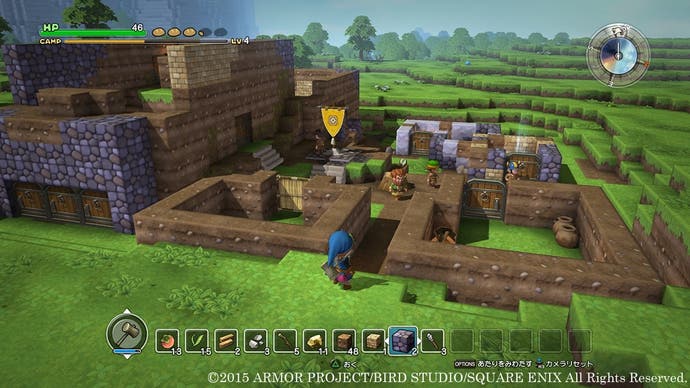
It's a tension that, for a long time, befuddled the Builders team. "The first draft of the game had a huge amount of freedom," explains Fujimoto. "You could do whatever you wanted. But we quickly ran into fatal problems. For example, the game might ask the player to go to a certain area that they had already completely destroyed." The team threw that version out and started again. "We started adding limitations till we struck a balance that seemed to work," he says. "For example, we would make certain landmarks indestructible to prevent you from blowing them up. But there might be a hundred different paths you could choose to get from A to B. In any other game you might have a road to get from A to B, but here you have the choice to dig a tunnel, or build a bridge. The journey itself is not laid out for you, even if the mission objectives are."
In the game you play as Bildrick, the only surviving citizen of Alefgard, the setting of 1986's Dragon Quest debut, who remembers the elemental human art of crafting. Everyone else has lost the ability to build things (wry commentary, perhaps, on the state of western manufacturing industries, with their forsaken mines and factories). While the game is quick to point out that Bildrick is not a hero he is nevertheless responsible for building the essential tools and buildings that will afford the people of Alefgard protection. In this way, you're guided through its blocky land and told precisely where to build certain structures in order to advance the story.
Play is, in other words, heavily directed. Whereas, in the original Minecraft, players are able to turn a heap of rocks into a shack, a mansion, a castle or a walled city according to whim, in Dragon Quest Builders you're told precisely where to put the window, or the door on your new home. With this shrinking scope comes the risk of a sense of diminished ownership over the world, although Fujimoto is quick to point out that there's a Free Build mode for anyone who wants to take down the barriers to the imagination, and build freely.
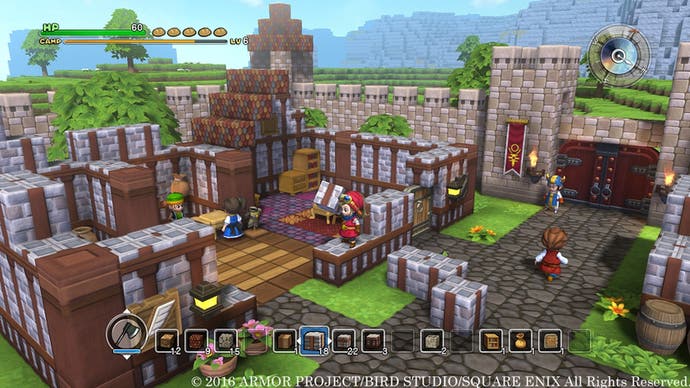
This is just the kind of tension that made development an arduous process, not from a labour perspective, but in terms of wrangling a design philosophy."It's a lot easier said than done when it comes to reconcile those tensions of freedom and form," says Fujimoto. "80 per cent of the challenge was simply making this blend work." Here's one example out of thousands, he says. "In Minecraft you can build a tower that is a thousand blocks high. If you have a quest in our game in which you have to defend your town from attack and you're a thousand blocks into the stratosphere, the mission just doesn't work. So, we made it so you an only build thirty blocks high. It's a limitation, but one that opens up lots of new possibilities. You lose a small amount of freedom, but it makes it much easier to make the story work." Why thirty blocks high? "There's no formulae for this stuff," he says. "We had to do it all on feeling. We constantly asked ourselves the question: does the story feel like it has momentum and structure while maintaining the sense of player freedom and exploration?"
It's a balance that, on early evidence, the team has ably struck. The game, which recently launched in Japan, has been well-received. While Fujimoto and the team hope that it's the start of something that could prove just as enduring as the series from which it borrows its title, Dragon Quest Builders carries another burden. It's a time of unprecedented decline in Japanese games industry, with major series faltering and, other than a few notable exceptions, many studios in spiralling decline. The kind of diversification of a major game series that Dragon Quest Builders and its cousin, Dragon Quest Heroes, represent are intended to have a stabilising effect, especially when major RPGs take years to build. Still, whether or not his game is a success, Fujimoto remains fully convinced of Dragon Quest's on-going survival. "There are so many complicated factors as to why Dragon Quest has endured in Japan," he. "The time at which the first game came out means that, for many generations, Dragon Quest represents comforting nostalgia. So long as we can keep hold of Yuji Horii's knack for storytelling and adventure, and Akira Toriyama's bright artwork, it will endure."
